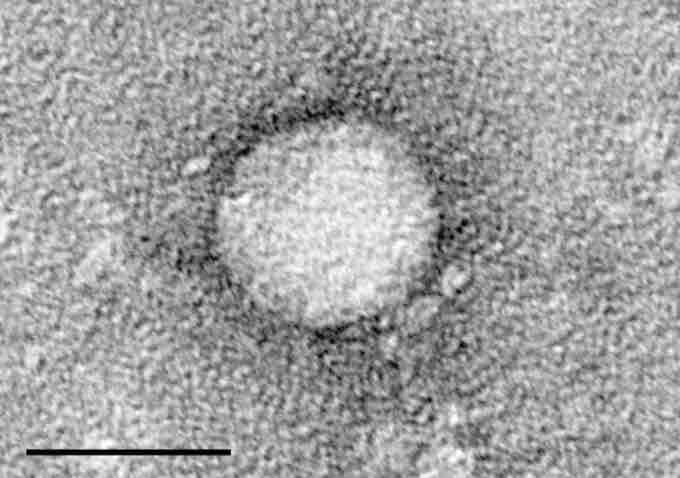There are two classes of cancer viruses: DNA and RNA viruses. Several viruses have been linked to certain types of cancer in humans. These viruses have varying ways of reproduction and represent several different virus families. Specifically, RNA viruses have RNA as their genetic material and can be either single-stranded RNA (ssRNA) or double-stranded (dsRNA). RNA viruses are classified based on the Baltimore classification system and do not take into account viruses with DNA intermediates in their life cycle. Viruses which contain RNA for their genetic material but do include DNA intermediates in their life cycle are called "retroviruses. " There are numerous RNA oncogenic viruses that have been linked to various cancer types. These various oncogenic viruses include:
1. Human T lymphotrophic virus type 1 (HTLV-I), a retrovirus, has been linked to T-cell leukemia. 2. The hepatitis C virus has been linked to liver cancer in people with chronic infections .

Electron micrograph of Hepatitis C
Hepatitis C viral infections have been linked to the development of liver cancer.
2. Hepatitis viruses includes hepatitis B and hepatitis C have been linked to hepatocellular carcinoma.
3. Human papillomaviruses (HPV) have been linked to cancer of the cervix, anus, penis, vagina/vulva, and some cancers of the head and neck.
4. Kaposi's sarcoma-associated herpesvirus (HHV-8) has been linked to Kaposi's sarcoma and primary effusion lymphoma.
5. Epstein-Barr virus (EBV) has been linked to Burkitt's lymphoma, Hodgkin's lymphoma, post-transplantation lymphoproliferative disease, and nasopharyngeal carcinoma.
RNA Retroviruses
Retroviruses are different from DNA tumor viruses in that their genome is RNA, but they are similar to many DNA tumor viruses in that the genome is integrated into host genome. Since RNA makes up the genome of the mature virus particle, it must be copied to DNA prior to integration into the host cell chromosome. This lifestyle goes against the central dogma of molecular biology in which that DNA is copied into RNA. The outer envelope comes from the host cell plasma membrane. Coat proteins (surface antigens) are encoded by env (envelope) gene and are glycosylated. One primary gene product is made, but this is cleaved so that there are more than one surface glycoprotein in the mature virus (cleavage is by host enzyme in the Golgi apparatus). The primary protein (before cleavage) is made on ribosomes attached to the endoplasmic reticulum and is a transmembrane (type 1) protein. Inside the membrane is an icosahedral capsid containing proteins encoded by the gag gene (group-specific AntiGen). Gag-encoded proteins also coat the genomic RNA. Again, there is one primary gene product. This is cleaved by a virally-encoded protease (from the pol gene). There are two molecules of genomic RNA per virus particle with a 5' cap and a 3' poly A sequence. Thus, the virus is diploid. The RNA is plus sense (same sense as mRNA). About 10 copies of reverse transcriptase are present within the mature virus, these are encoded by the pol gene. Pol gene codes for several functions (again, as with gag and env, a polyprotein is made that is then cut up).